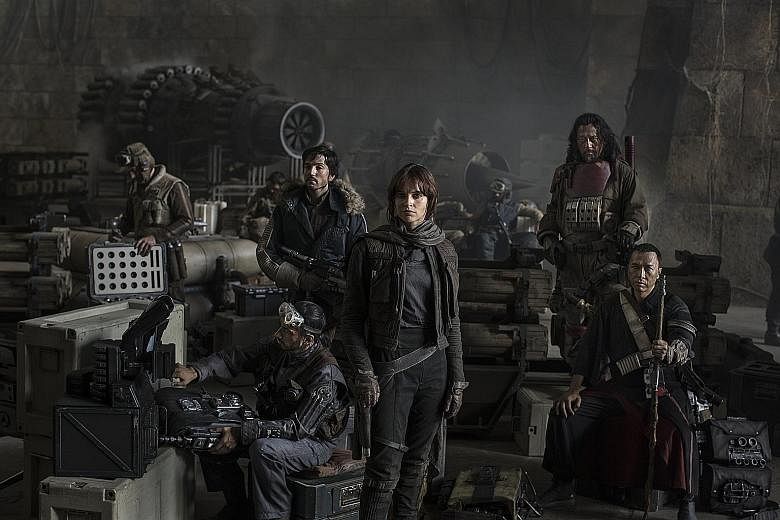LOS ANGELES • It grossed US$1 billion (S$1.4 billion) and picked up numerous award nominations, but a particular aspect of Rogue One: A Star Wars Story caused one of the biggest controversies in the entire franchise.
(Minor spoilers follow.)
Fans were polarised by the computer-generated appearances of the long-dead Peter Cushing and a youthful Carrie Fisher in last year's film, with some admiring the technical wizardry, but many dismissing their inclusion as downright creepy.
With Lucasfilm planning to release the DVD and Blu-ray of Rogue One on April 4, fans will get an insight into just how well the film's crew understood the huge risk of diving into the "uncanny valley" of computer-generated human images.
In a bonus featurette, The Princess And The Governor, animation supervisor Hal Hickel discusses a cutting-edge special-effects process he describes as a "long series of failures resulting in victory". "There were many dark days, many sleepless nights, laying awake, worrying about these shots," he says.
Developed by a Japanese robotics professor in 1970, the "uncanny valley" is the hypothesis that human replicas that appear almost, but not quite, like real humans, elicit feelings of revulsion.
The name refers to the sudden dip in people's emotional response, which generally grows more positive the more human the replicas look - until they are so lifelike that people are creeped out.
"Close-up digital human work is one of the hardest problems in computer graphics," visual effects supervisor John Knoll explains in the featurette.
"You don't want to be sitting there in the theatre saying, 'Yeah, something doesn't look right. What do you think that is?'"
Unfortunately, this was the exact reaction of numerous otherwise rapt critics.
Cushing, who played villainous Death Star commander Grand Moff Tarkin in the original 1977 film, died in 1994, while Fisher had stopped looking like a 19-year-old Leia decades before her death just two weeks after Rogue One came out.
So, the idea of creating CGI versions of the actors was hugely divisive, with The Washington Times' Eric Althoff dismissing their inclusion as weird.
USA Today's Kelly Lawler complained that while Tarkin was "unnerving", the Leia cameo was "so jarring as to take the audience completely out of the film at its most emotional moment".
In the film, Tarkin and Leia are played by Guy Henry and Ingvild Deila, with the digital likenesses of the original actors superimposed on them by San Francisco-based effects studio Industrial Light & Magic.
"It takes a lot of preparation to get into this character because everyone remembers Leia very well, so it needs to look exactly right," Deila explains in the featurette.
"And so, they spent a lot of time on my hair, obviously. They dyed it twice and then added some extra hair... in the front because her hairline is a bit lower than mine. And also a big chunk of hair to make the buns.
"Then, all these dots were put on right before we started shooting so that they could put Carrie Fisher's face on top of mine."
While archived audio was mined for Leia's sole word of dialogue, Henry came up with a passable Cushing impersonation for his substantial scenes.
"It was a very difficult process because there's no way to really go back in time and capture the appearances of these actors," said Industrial Light & Magic creative director Paul Giacoppo.
"So, we had to bring every single possible skill set to bear, to try to re-create the details of their facial appearance and skin likeness and performance."
Lucasfilm president Kathleen Kennedy, a producer on the movie, says she would not have green-lit the digital resurrections if visual effects supremo Knoll had not been so confident that he could pull it off.
As for Fisher, she managed to see the computer-generated cameo before her death last December at the age of 60, and gave it her blessing, Mr Knoll told ABC News.
"She was involved in the process and, you know, she saw the final result and she loved it," he said.
"She got to see the scene. Kennedy showed it to her. So, I got a call afterwards from Kathy saying, 'Well, Carrie loved it.'"
AGENCE FRANCE-PRESSE

